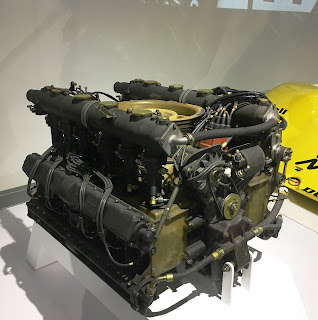A historic Porsche 917K
For the 1970 season, the world motorsports governing body
the Fédération Internationale de l'Automobile (FIA) designated that Group 4
Sports Cars with maximum engine capacity of 5 liters (305 cubic inches) would contest
the FIA's International Championship for Makes in 1970 & 1971.
Author's copy of an original 917 brochure
The Porsche racing department designed and built the 917 in just nine months and on March 12, 1969, a 917 was displayed to the public at the Geneva Motor Show. Qualifying manufacturers had to build 25 examples (down from the original 50), and on April 20 1969 Porsche displayed a line of 25 completed 917s which met the new FIA regulations with two seats, a luggage compartment, spare tire, turn signals, turn-key ignition, and a horn.
The 917 was designed by Porsche chief engineer Hans Mezger
using a lightweight aluminum spaceframe chassis which weighs less than 100
pounds. Power came from a new 4.5-liter (274 cubic inch) air-cooled engine featured
a 180° flat-12 cylinder layout, with twin overhead camshafts and two spark
plugs per cylinder fed from twin distributors. The large horizontally mounted
cooling fan was driven from centrally mounted gears.
Porsche’s first 12-cylinder engine produced 520 horsepower
at 8000 revolutions per minute and used and aluminum crankcase and cylinder
heads along with the use of such exotic materials as titanium (for the
connecting rods) and magnesium. To keep the car compact despite the large
engine and longitudinal transmission, the driver’s position is so far forward
that the driver’s feet are ahead of the front axle. The entire machine fueled
and ready to race weighs less than 1800 pounds.
Details of the original 917 tail designs
In testing the original design of the 917 proved to be, at
least according to test driver Brian Redman "incredibly unstable, using
all the road at speed,” while fellow test driver Jo Siffert reported that the car
“is not only unstable, but it is frankly dangerous.” The 917’s results during
the 1969 racing season were disappointing so for 1970 J.W. Automotive Engineering
(JWA) became the Porsche factory racing and development team.
Run by John Willment and his partner John Wyer who had won
the 24 hours of LeMans as a team manager three times in 1959, 1968, and 1969
the team had sponsorship from the Gulf Oil Company. In early testing of the unstable 917, the JWA
engineers created a new wedge shaped tail, called the ‘kurzer shwanz‘ or ‘short tail’
which transformed the car’s handling and this revised car became known as the
917K.
The new Porsche 917K raced for the first time at the 1970 24
Hours of Daytona held on the 3.8-mile Daytona International Speedway road
course. This car, chassis 917-015 (race number 2) assigned to Mexican driver Pedro
Rodriquez and Finnish driver Leo Kinnunen, qualified third behind their JWA
team car (race number 1) driven by Jo Siffert and Brian Redman.
The blue and orange #2 Porsche 917K took the race lead 2
hours and 35 minutes into the event and never relinquished the lead, and
completed 724 laps (a new record) 45 laps ahead of the #1 Porsche 917K. In an
interesting twist, Redman wound up driving both the first and second place
cars, as he drove one stint in place of Kinnunen.
The Gulf Porsche 917Ks dominated the 1970 International Championship
for Makes, as they won six of the ten rounds; Rodriquez and Kinnunen won four
races, while Siffert and Redman won two rounds. At the crown jewel of the
series, the 24 hours of LeMans, while the JW team did not win, but a 917K won, entered
by the Porsche racing department and driven by Richard Attwood and Hans Hermann.
Porsche 917Ks returned for 1971, the second and final year
of the FIA rules package, and one again were dominant, as they won six of the eleven
races and were again crowned the International Makes champion. The JW Gulf Porsches won five
1971 rounds, but fell short again at LeMans and finished second to a similar Porsche 917K
entered by Martini & Rossi Racing.
The 1970 Daytona 24-hour winner chassis 917-015 shown as
part of ‘The Porsche Effect’ exhibit at the Petersen Automotive Museum was
restored and is owned by Bruce Canepa of Scotts Valley California. For
more detailed photographs of this immaculate machine visit http://canepa.com/museum/1969-porsche-917k-015/
Color photographs by the author
Color photographs by the author







This comment has been removed by the author.
ReplyDelete